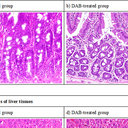Optimization of bioactive compounds in buckwheat sprouts and their effect on blood cholesterol in hamsters.
Nøgleord
Abstrakt
Nutrient levels in buckwheats that were maximized in day 8 sprouts (D8SP) included total phenolics, quercetin, and l-ascorbic acid, whereas those of oxalic, malic, tartaric, and citric acids, rutin, and gamma-aminobutyric acid (GABA) were found to reach maximum levels on day 10. Ethanolic extract of D8SP (2.5 mg/mL) revealed potent free-radical scavenging (FRS) and antioxidative (ANO) capabilities. However, its Fe2+-chelating capability was only moderate. To further study the hypolipidemic activity of D8SP, 36 Syrian hamsters were grouped into six groups and fed for 28 days, respectively, with (i) control meal, (ii) high fat plus high cholesterol meal, (iii) high fat plus high cholesterol plus 2.5% of buckwheat seeds, (iv) high fat plus high cholesterol plus 25% of buckwheat seeds, (v) high fat plus high cholesterol plus 2.5% of D8SP, and (vi) high fat plus high cholesterol plus 25% of D8SP. High seed meal prominently enhanced body weight gain, whereas high sprout meal exhibited the highest feed efficiency. Ratios of liver/body weight (L/B) were significantly lowered by all BS meals. Although low seed meal reduced serum total cholesterol (TC) levels (p<0.05), its effect was still inferior to the high seed and sprout meals (p<0.01). In contrast, serum triglyceride (TG) levels were lowered only by the high seed and sprout meals (p<0.05). Alternatively, levels of serum low-density lipoprotein cholesterol (LDL-C) were significantly suppressed by all buckwheat meals (p<0.01). Serum high-density lipoprotein cholesterol (HDL-C) levels were increased, however, insignificantly. Nutraceutically more meaningful is that both LDL-C/HDL-C and TC/HDL-C ratios were significantly lowered (p<0.01). Apparently, hepatic TC levels were significantly reduced, whereas hepatic TG levels were totally unaffected. Conclusively, sprouting triggers a variety of nutritional changes in buckwheats. Day 8 sprouts, consisting of high polyphenolic and moderate quercetin contents, are nutraceutically maximized when hypocholesterolemic, hypotriglyceridemic, and antioxidative activities are concerned.


